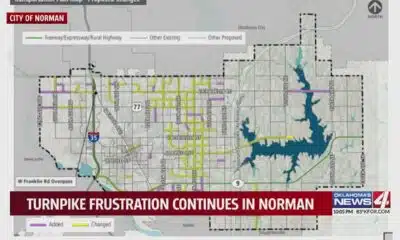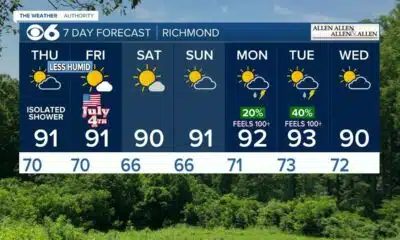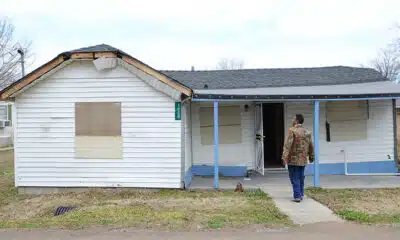News from the South - North Carolina News Feed
Why is so much plastic hung up in trees and shrubs, and when will it get cleaned up? Will Asheville Muni close at the end of March? • Asheville Watchdog
Today’s round of questions, my smart-aleck replies and the real answers:
Question: Why is there so much plastic hung up in trees and shrubs from Helene? Where did it all come from? Will anyone clean it up? When?
My answer: This is undoubtedly the worst Christo exhibit ever. I just don’t get his vision on this one.
Real answer: It is hard to miss all of the debris still hanging from trees and brush along our river and stream banks. Naturally, Tropical Storm Helene is to blame.
The 1,000-year rains swelled rivers to upward of 30 feet deep in some places. That’s high enough to get into the tree line, and that’s where a lot of debris landed.
The debris remains highly noticeable, said Anna Alsobrook, the French Broad watershed science and policy manager at MountainTrue, an Asheville environmental nonprofit.
“While it’s gotten better with the help of volunteers picking it up in places, the amount of plastic hanging from trees looks apocalyptic,” Alsobrook told me via email. “Take a minute and think about how hard it is for us as individual consumers to buy anything that’s not wrapped in or packaged in plastic. The same is true for retailers, manufacturers, and industries, but the amount and volume is much greater for them.”
Whatever was next to our rivers and streams went into the water, including plastic.
“So, when a building was flooded, anything inside of it came out, including all the packaging, plastic waste, etc., that may have been inside,” Alsobrook said. “On top of that, plastic is a major part of building material — whether as insulation or under roofing.”
We do have some good news to report.
“MountainTrue is working to clean up where and how we can with the help of some really rockstar volunteers,” Alsobrook said. “I’m telling you, they have braved some subpar conditions lately! That being said, we are staying out of the way of the debris contractors hired to remove the bigger debris, like cars, tankers etc.”
Hartwell Carson, the French Broad riverkeeper with MountainTrue, provided details on river cleanup progress.
“Between our Green Riverkeeper, French Broad Riverkeeper and Watauga Riverkeeper programs, we have hauled out over 2.8 million pounds of garbage from our rivers since the storm,” Carson said. “We have hired a full-time cleanup coordinator, acquired a new vehicle and purchased a dump trailer. We are also employing over a dozen raft guides in Madison County to clean up the whitewater section of the French Broad River and are hoping to ramp up our cleanup team to include 25 to 50 staff.”

Additionally, the U.S. Army Corps of Engineers announced Feb. 1 that the Corps, “in coordination with federal, state, and local partners, has officially launched a waterway debris removal mission in North Carolina to support recovery efforts following Hurricane Helene.
“The mission focuses on clearing storm-related debris from navigable waterways, ensuring public safety, protecting critical infrastructure, and preserving the environment,” the Corps said in the news release.
Col. Brad Morgan, Wilmington District Commander for the Corps, noted that Helene “left significant debris in key waterways, posing risks to recreation and ecosystems.
The Corps said the recovery work will be done “in close coordination with local agencies and stakeholders.”
Carson said they’ve learned that the Army Corps’s cleanup efforts, “for now, will only cover major tributaries and only big debris that threatens critical infrastructure.
“Think cars, shipping containers, etc.,” Carson said. “That means there will be a huge amount of trash left after the cleanup effort and MountainTrue is stepping up to make sure this trash is cleaned up, so we can get back on our rivers and outfitters reopen.”
Plastic material stuck in trees is “a good example of the kind of trash that the Army Corps won’t be removing,” Carson said.
Stacey Reese, a spokesperson for the Corps, said via email they are tasked with removing these types of debris: vegetative, construction and demolition, titled property (boats, cars, etc.), white goods, and hazardous materials.”
“We will work on points given to us by the county and FEMA, and (we’ll be) working in areas FEMA deems eligible,” Reese said. “The waterway debris removal began in Buncombe County, Azalea Park area on Saturday.”
Alsobrook said once the Corps’ teams have completed the heavy machinery work, “we plan to come back in and tackle the hand-pickable items.”
If you’re interested in volunteering, check MountainTrue’s events calendar at mountaintrue.org/events.

Question: I just heard that the Asheville Muni Golf Course may close in March. If true, that is not fair to those who paid for a season’s pass. The first three months of the year there is limited play due to winter weather. Can you get details?
My answer: I recently played the back nine of the Muni twice consecutively, as only the back nine is open now. I was thinking that playing the same nine twice, I naturally would smoke the course and shoot my best score ever. Funny how that didn’t work out.
Real answer: Closure is highly unlikely.
The Muni’s front nine, the part closest to Swannanoa River Road and the river itself, was heavily damaged, but the back nine reopened in October, after the city cleared multiple downed trees.
“The front nine will clearly be some time before we are able to reopen,” said Chris Corl, the city of Asheville’s director of community and regional entertainment facilities.

Corl noted that City Council in December approved an amendment to the licensing and management agreement contract with Commonwealth Golf Partners to operate the course that adjusted the profit-and-loss share structure between the city and Commonwealth. It placed 100 percent of profits and loss with the city, paying Commonwealth a small monthly management fee to operate the course on the city’s behalf, Corl said.
“Included was a provision that beginning April 1, 2025, the agreement would revert back to the original profit-and-loss share structure, which is roughly a 50/50 split between the city and Commonwealth,” Corl said.
The amendment covering Oct. 1, 2024 through March 31, 2025 is designed to give the city time to work out a longer-term, temporary agreement with Commonwealth. Corl said the city is in conversation with Commonwealth to determine “what a contract structure can look like, assuming that the course remains a nine-hole course for up to two years, as we work through the process to rebuild while following the necessary steps and timelines associated with potential FEMA reimbursement.”
Regarding the 2025 annual passes, the city purposely formulated them with quarterly payments to allow for the potential shakeup in the operating structure starting April 1.
“I understand that this January we’ve had an abnormally high number of days with the course closed due to weather, but that is always a possibility in the winter and affects annual passholders and non-passholders every year,” Corl said.
The bottom line, Corl said, “is that the course will not close in March.
“However, I should be clear that we have an existing approved agreement through March 31,” Corl said. “April 1 and after, we are still working through, and all options are on the table, as reverting to the original contract structure pre-storm is not feasible for us and Commonwealth.”
“We’re certainly doing everything in our power to work on a result and a financial model that continues course operations, but to be prudent stewards of our current financial situation, we need to look at all potential options,” Corl continued.
Michael Bennett, a partner in Commonwealth Golf Partners, said Corl’s assessment is correct. He also noted that the annual passes are paid only through the end of March.
Closure is doubtful, Bennett said.
“I just don’t see it,” Bennett said. “Chris has been very good to work with.”
Bennett noted that the course was in great shape before Helene, with the restoration nearly complete.
“We really just finished everything except for those two bunkers on 18 — that was the only thing we had left to do,” Bennett said. “We stopped in June because we didn’t want to disturb them ahead of the Skyview Tournament.”
Business was good before the storm, Bennett said, and he noted that the course, a Donald Ross design dating to the 1920s, still has fantastic potential.
“So to close it would be pretty tragic,” Bennett said. “I don’t think anybody really thinks that that’s going to happen. It’s just more mechanical — like, ‘OK, how do we continue to fund this while it’s just a nine-hole golf course?’ Because it’s nearly impossible to make any money operating a nine-hole golf course, because the expenses aren’t half of what you might think they are.”
Corl said before Helene the city was about 95 percent done with the renovation project. As of September 2024, the city had spent $3,018,468 on it.
The city received funds towards the project from the Buncombe County Tourism Development Authority’s Tourism Product Development Fund, the Donald Ross Society Foundation, hole sponsorships, private donations made through the Friends of Asheville Municipal, and the city.
For now, Bennett said, the idea is to keep maintaining the course, and find a way to keep it open and at least not losing money.
Bennett said the “worst-case scenario” for the front nine to remain closed is probably about two years, although he emphasized nothing has been determined on the rebuilding schedule.
He did note that Commonwealth and the city submitted a detailed damage assessment to FEMA about two weeks ago, so he’s optimistic that will help to get the process rolling.
“Because we were one of the first ones in, we all believe that we’ll be one of the early ones to get reviewed,” Bennett said.
Asheville Watchdog is a nonprofit news team producing stories that matter to Asheville and Buncombe County. Got a question? Send it to John Boyle at jboyle@avlwatchdog.org or 828-337-0941. His Answer Man columns appear each Tuesday and Friday. The Watchdog’s reporting is made possible by donations from the community. To show your support for this vital public service go to avlwatchdog.org/support-our-publication/.
Related
The post Why is so much plastic hung up in trees and shrubs, and when will it get cleaned up? Will Asheville Muni close at the end of March? • Asheville Watchdog appeared first on avlwatchdog.org
News from the South - North Carolina News Feed
AAA travel forecast: Lower gas prices, hit the roads early
SUMMARY: Millions of Americans are expected to travel this July 4th holiday, with Sunday and today being the busiest driving days. AAA estimates a record 61.6 million people will hit the road, urging travelers to leave before noon to avoid heavy traffic between 12 p.m. and 9 p.m. Gas prices offer relief, with summer prices at their lowest since 2021. In Raleigh, gas averages around \$2.93 per gallon, slightly above the state average. Prices in Wilmington and Asheville are about \$2.91 and \$2.90, respectively. Statewide, gas prices have recently decreased by several cents.
Wednesday is the busiest day of road travel before the July 4 holiday, according to AAA.
News from the South - North Carolina News Feed
Population loss in Western NC after Helene expected
In the aftermath of Tropical Storm Helene, some in government and the news media were sounding the alarm on the prospect of population loss in affected areas of the state. The fear that there would be a mass exodus from the North Carolina mountains was contagious.
The storm’s effect on the population will likely not be as dramatic as some imagined, but that doesn’t mean nothing has changed. It’s hard to say, nine months out, what to expect as the situation continues to develop.
But some clues have come into focus.
[Subscribe for FREE to Carolina Public Press’ alerts and weekend roundup newsletters]
State demographer Mike Cline thinks that, in the best-case scenario, the region will lose about 5% of its displaced population. The worst-case scenario could result in population loss as high as 35% among those who have been displaced.
Two factors affecting population were already in play. Families were being priced out of Western North Carolina — and the population has been aging.
Then came Helene. Some lost their homes and were forced to leave. They often had no choice. Some evacuated and never came back. People lost loved ones, pets, cars, businesses and so much more that had tied them to the area.
While most people who left their community will take up residence somewhere else in Western North Carolina, according to Cline, some won’t. Those who do return are likely to be older and have more financial resources than those who do not.
On the other hand, many, many people have stayed put and appear likely to remain where they are.
“When you have a disaster, people want to know immediately what is happening,” Cline told Carolina Public Press. “Most studies show that 65% to 95% of people, depending on the disaster, will return within six months to a year.
“But the data is limited. Most of Western North Carolina’s population live in unincorporated communities or very small towns. When you have a smaller population, it’s harder to track.”
But that doesn’t stop him from trying.
His office formed an ad-hoc subcommittee to meet and discuss the issue of population change post-Helene. They look at housing permits, demolition rates, rehabilitated properties, school enrollments and surveys of local governments.
From there, they can start to get a sense of how many people were displaced and unlikely to return. But they are wary to release anything official until more robust data is available.
Changing population migration patterns
The storm may deter or delay people who were thinking of moving or retiring to Western North Carolina.
“Are the people who were planning to move here actually going to move now?” Cline asked. “That’s where I think the greatest impact in terms of future growth or change will be.”
The region was seen as something of a “climate haven” before Helene, a place where one could be safe from extreme temperatures, sea-level rise and natural disasters, according to Mitchell County resident Lori Gilcrist.
The mountains have lost that status, she says. The chance of something like Helene happening again may decrease the region’s popularity.
It also could be the final straw for someone who was thinking of leaving the region already.
But Gilcrist, for one, said she is not going anywhere.
One factor Cline talks about is the “rootedness” of the region. Even though it’s a popular retirement destination, some families have been there for generations, folks born and raised and still living in the same communities their great-grandparents did.
That Appalachian rootedness may insulate the region from extreme population loss.
Academic aftershocks
But for some populations, like the student population at Appalachian State University in Boone, for example, that rootedness is not really a factor.
“There were a lot of students who had housing problems and real psychological trauma, during and right after the event,” said Colin Kelley, a professor of climate science at App State. “Many had to go home to help their families or deal with their own problems.”
In the Henderson County school system, enrollment dropped by 283 students after the storm.
That number includes families who left the region completely, relocated to a different school district or withdrew their children from school while dealing with the aftermath.
In Buncombe County, eight schools experienced “large losses” in the student body, meaning losses of 20 students or more.
But school officials in Haywood and McDowell County say enrollment numbers have been steadily declining for years, so it’s hard to say how different things would have looked if Helene had not happened.
That’s the prevailing feeling in the Haywood County government as well.
“It’s really difficult to quantify population changes and even more so to attribute any shifts directly to Helene,” said Dillon Huffman, the public information officer for Haywood County.
“From a local government perspective, I don’t know how we associate anything as a direct result of the storm. In fact, I would venture to say that Haywood County has grown in terms of overall population over the past year. One indicator we keep an eye on is building permit activity, which remains strong.
“We won’t have official Census data for another five years, and we’re only nine months out from Helene — it’s tough to establish meaningful trends in such a short window.”
Clarification: This article has been updated to show that the predicted 5% to 35% population loss for Western North Carolina is among just the displaced portion of the population and not the overall population. An earlier version of the article was unclear on that point.
This article first appeared on Carolina Public Press and is republished here under a Creative Commons Attribution-NoDerivatives 4.0 International License.
The post Population loss in Western NC after Helene expected appeared first on carolinapublicpress.org
Note: The following A.I. based commentary is not part of the original article, reproduced above, but is offered in the hopes that it will promote greater media literacy and critical thinking, by making any potential bias more visible to the reader –Staff Editor.
Political Bias Rating: Centrist
This article provides a factual and balanced report on the population impacts following Tropical Storm Helene in Western North Carolina. It relies on data from multiple sources, including state demographers, local officials, and academics, presenting varying perspectives without editorializing or advocating for a specific political viewpoint. The language is neutral, focusing on observed effects and uncertainties without emotional or ideological framing. There is no clear alignment with partisan or ideological stances, reflecting an objective, data-driven approach typical of centrist reporting.
News from the South - North Carolina News Feed
Republicans rewrote the US Senate megabill in its last moments
SUMMARY: Senate Republicans finalized a major bill with last-minute changes addressing Medicaid cuts, rural hospital funding, SNAP costs, and clean energy tax credits. The rural hospital fund was doubled to \$50 billion and payments accelerated to 2026 to offset Medicaid cuts. SNAP provisions allow certain states with high payment error rates to delay sharing program costs until 2029. A clean energy excise tax on solar and wind projects was removed before the vote, while deadlines for energy tax credits were extended to encourage investment. Despite changes, Senators Collins, Tillis, and Paul opposed the bill; Vice President JD Vance broke the tie.
The post Republicans rewrote the US Senate megabill in its last moments appeared first on ncnewsline.com
-
Mississippi Today6 days ago
Defendant in auditor’s ‘second largest’ embezzlement case in history goes free
-
News from the South - Georgia News Feed5 days ago
Are you addicted to ‘fridge cigarettes’? Here’s what the Gen Z term means
-
The Conversation6 days ago
Toxic algae blooms are lasting longer than before in Lake Erie − why that’s a worry for people and pets
-
News from the South - Tennessee News Feed6 days ago
5 teen boys caught on video using two stolen cars during crash-and-grab at Memphis gas station
-
Local News6 days ago
Mississippi Power shares resources and tips for lowering energy bill in the summer
-
News from the South - Kentucky News Feed7 days ago
Error that caused Medicaid denials has been corrected, says cabinet in response to auditor letter
-
News from the South - Georgia News Feed7 days ago
GOP mega-bill stuck in US Senate as disputes grow over hospitals and more
-
News from the South - South Carolina News Feed5 days ago
Federal investigation launched into Minnesota after transgender athlete leads team to championship











































